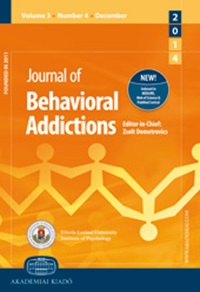The influence of age on gambling problems worldwide: A systematic review and meta-analysis of risk among younger, middle-aged, and older adults.
IF 6.6
1区 医学
Q1 PSYCHIATRY
引用次数: 0
Abstract
Background and Aims Problem gambling (PG) represents a significant public health concern with widespread effects in various cultures and regions globally, with younger individuals and males at a particularly higher risk. This disparity is attributed to a mix of cultural, developmental, and biological influences. To date, there has not been a comprehensive examination to determine whether this risk pattern holds consistently across different jurisdictions. Methods We performed a systematic review and meta-analysis using the PRISMA framework, identifying 21 eligible studies from 18 countries, encompassing 156,249 participants (47.6% male and 52.4% female). Results The studies varied considerably by region (Asia: 19%, Europe: 52%, Oceania: 19%, North America: 10%), the diagnostic criteria for PG, and participation rates in gambling (ranging from 12% to 92%). Data on PG prevalence was categorised by gender and three age groups (young: 18-35, middle: 30-55, and older: 45-65). Using a random-effects meta-analysis, we found a global PG prevalence of 1.9%. Europe reported a significantly lower prevalence (1.3%) compared to North America (5.3%). Men were found to be 3.4 times more likely than women to engage in problem gambling, although the gap narrows in North America. The young demographic showed a 1.51 times higher likelihood of reporting PG compared to the middle-aged group, whereas older adults were 0.80 times less likely to report PG. Notably, age-related effects varied significantly across regions. Conclusions Our findings confirm that age and gender significantly influence PG risk across cultures, with significant heterogeneity observed across jurisdictions.年龄对全球赌博问题的影响:对年轻人、中年人和老年人赌博风险的系统回顾和荟萃分析。
背景和目的问题赌博(PG)是一个重大的公共卫生问题,在全球不同文化和地区都有广泛影响,年轻人和男性的风险尤其高。这种差异可归因于文化、发育和生理的综合影响。我们采用 PRISMA 框架进行了系统回顾和荟萃分析,确定了来自 18 个国家的 21 项符合条件的研究,涉及 156249 名参与者(47.6% 为男性,52.4% 为女性)。结果这些研究因地区(亚洲:19%;欧洲:52%;大洋洲:19%;北美洲:10%)、PG 诊断标准和赌博参与率(从 12% 到 92% 不等)的不同而存在很大差异。有关 PG 患病率的数据按性别和三个年龄组(青年:18-35 岁,中年:30-55 岁,老年:45-65 岁)进行了分类。通过随机效应荟萃分析,我们发现全球 PG 患病率为 1.9%。欧洲的发病率(1.3%)明显低于北美(5.3%)。男性参与问题赌博的几率是女性的 3.4 倍,尽管在北美这一差距有所缩小。与中年群体相比,年轻人报告有问题赌博的可能性高出 1.51 倍,而老年人报告有问题赌博的可能性则低 0.80 倍。结论我们的研究结果证实,年龄和性别对不同文化背景下的 PG 风险有显著影响,不同辖区之间存在显著的异质性。
本文章由计算机程序翻译,如有差异,请以英文原文为准。
求助全文
约1分钟内获得全文
求助全文
来源期刊

Journal of Behavioral Addictions
PSYCHIATRY-
CiteScore
12.30
自引率
7.70%
发文量
91
审稿时长
20 weeks
期刊介绍:
The aim of Journal of Behavioral Addictions is to create a forum for the scientific information exchange with regard to behavioral addictions. The journal is a broad focused interdisciplinary one that publishes manuscripts on different approaches of non-substance addictions, research reports focusing on the addictive patterns of various behaviors, especially disorders of the impulsive-compulsive spectrum, and also publishes reviews in these topics. Coverage ranges from genetic and neurobiological research through psychological and clinical psychiatric approaches to epidemiological, sociological and anthropological aspects.
 求助内容:
求助内容: 应助结果提醒方式:
应助结果提醒方式:


